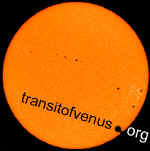[Whoa! The search for planets by using transits has progressed so quickly that I can't keep up with all of the discoveries. While that in itself is good news, this page quickly becomes dated. I will resume updating this page at a later date. Thanks for understanding.]
 http://soho.nascom.nasa.gov
http://soho.nascom.nasa.gov
SOHO spacecraft monitors the sun.
- http://soho.nascom.nasa.gov/pickoftheweek/old/01nov2002/
SOHO captures Venus in field of view below the sun in November, 2002. - http://soho.nascom.nasa.gov/explore/Sun_Obs.html
How Do We Observe the Sun? shows how data helps account for the things we do not understand. - http://sohowww.nascom.nasa.gov/data/realtime-images.html
The latest SOHO images, plus a screensaver with real time SOHO images. - http://sohowww.nascom.nasa.gov/spectacular/1999_11_15/
SOHO captures a grazing transit of Mercury in 1999. - http://soho.nascom.nasa.gov/pickoftheweek/old/SunAsArt/
The Sun as Art captures the majesty, the mystery, and the power of the sun. - http://solar-center.stanford.edu/singing/singing.html
The Singing Sun, a recording of acoustical pressure waves in the Sun made by carefully tracking movements on the Sun's surface.
SOHO astronomers note...
- Venus can likely be used "for calibration purposes for both LASCO and UVCS coronagraphs. Its brightness can be used for refining visible light radiometric quantities and its position (before the transit) can be used for absolute pointing corrections. During the transit on the disk, Venus may be similarly useful for the disk imagers (EIT and MDI)." --Leonard Strachan
- "Unfortunately, the Venus transit will not be a disk transit seen from SOHO. Although we're roughly in the same direction as Earth seen from the Sun, there are some differences (the Sun is a very powerful radio source, so to avoid interference with our downlink we can never be directly in from of the Sun as seen from Earth). It will be a coronal transit, though, much like the Mercury transit of 1999 (see http://soho.nascom.nasa.gov/hotshots/1999_11_15/). Venus will be a much bigger dark spot, though!" --Stein Vidar Hagfors Haugan
 http://sohowww.nascom.nasa.gov/hotshots/
http://sohowww.nascom.nasa.gov/hotshots/
The satellite's Keyhole--its definition, its significance, its challenges,
its impact--is well explained as SOHO takes the pulse of the sun. See what the SOHO team is thinking
and how they respond to satellite challenges. 04-01-22
 http://sohowww.nascom.nasa.gov/hotshots/
http://sohowww.nascom.nasa.gov/hotshots/
SOHO captures Mercury transit on May 7, 2003. Still images and movies
available.
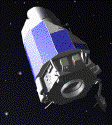 http://www.kepler.arc.nasa.gov/index.html
http://www.kepler.arc.nasa.gov/index.html
NASA's newly approved Kepler mission will search for earth-class planets
by looking for transits of planets around 100,000 distant stars.
- http://www.kepler.arc.nasa.gov/summary.html
Overview page offers both a detailed and a condensed summary of the mission.- http://www.kepler.arc.nasa.gov/downloading.html
Downloadable Images and Animations- http://www.kepler.arc.nasa.gov/model.html
Paper model of spacecraft- http://www.kepler.arc.nasa.gov/character.html
Describes three parameters that describe characteristics of planetary transits; lists transit properties of solar system objects; suggests from geometric probability that "1% of solar-like stars with planets should show Earth-size transits."- http://www.kepler.arc.nasa.gov/faq.html
FAQ answers questions about why the search can't be from the ground, why the Hubble Space Telescope can't be used for this mission, other factors that change a star's brightness, and how CCDs work.
http://www.space.com/searchforlife/seti_transits_030904.html
"Solar Transits: Tools of Discovery" article by Edna DeVore
describes how transits are significant both as historical events and as
cutting-edge research tools.
 http://exoplanets.org/
http://exoplanets.org/
California & Carnegie Planet Search keeps you current on exo-planet research
and almanacs.
 http://www.psi.edu/esp/process.html
http://www.psi.edu/esp/process.html
"Search for extra-solar planets, or planets orbiting stars other than the
Sun, by the transits they make..."
 http://www.space.com/searchforlife/seti_doyle_worlds_010809.html
http://www.space.com/searchforlife/seti_doyle_worlds_010809.html
SETI document describes detecting other worlds using the photometric
transit or 'wink' method; by Dr. Laurance Doyle.
 http://cfa-www.harvard.edu/press/pr0301.html
http://cfa-www.harvard.edu/press/pr0301.html
Press release (Jan. 6, 2003) announces first planet detected by transit method,
which used ground-based telescopes.
 http://www.eso.org/outreach/press-rel/pr-2003/pr-09-03.html
http://www.eso.org/outreach/press-rel/pr-2003/pr-09-03.html
ESO press release (April 22, 2003) announces discovery of glowing hot transiting
exoplanet.
 http://www.spaceref.com/news/viewpr.html?pid=14873
http://www.spaceref.com/news/viewpr.html?pid=14873
Press release (August 24, 2004): "Network of small telescopes discovers distant
planet (TrES-1)." Image courtesy of NASA JPL.
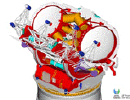 http://planetquest.jpl.nasa.gov/news/lbti_update.html
http://planetquest.jpl.nasa.gov/news/lbti_update.html
Large Binocular Telescope (LBT) "will enable astronomers to carry out a
broad range of unprecedented astronomical observations, including some of the
first direct observations of giant planets around other stars."
 http://itss.raytheon.com/cafe/qadir/q2710.html
http://itss.raytheon.com/cafe/qadir/q2710.html
TRACE spacecraft captures image of Mercury transiting sun in 1999.
 http://vestige.lmsal.com/TRACE/POD/images/Mercury2003_combo.gif
http://vestige.lmsal.com/TRACE/POD/images/Mercury2003_combo.gif
TRACE spacecraft captures image of Mercury transiting sun in 2003. For
more transit of Mercury images and movies see http://www.williams.edu/astronomy/eclipse/transits/index.html#mercury.
 http://antwrp.gsfc.nasa.gov/apod/ap991106.html
http://antwrp.gsfc.nasa.gov/apod/ap991106.html
False color x-ray images of Mercury transiting sun taken by the Yohkoh
satellite.
 http://genesismission.jpl.nasa.gov/
http://genesismission.jpl.nasa.gov/
A collection of educational materials relating to the sun, its effects, and the Genesis
mission. The Genesis spacecraft, sent "a million miles sunward
to collect pieces of the sun, called solar wind, ... unfolded its collectors and
began a two-year 'sunbath.' Upon its return to Earth in 2004, scientists
will study the solar wind samples."
http://messenger.jhuapl.edu/animations.html
Animations show Messenger spacecraft imaging Venus during a flyby on June
24, 2004, after the transit of Venus.
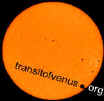 The solar image in our
logo is from the SOHO spacecraft.
The solar image in our
logo is from the SOHO spacecraft.
 http://sunearth.gsfc.nasa.gov/sunearthday/2004/index_vthome.htm
http://sunearth.gsfc.nasa.gov/sunearthday/2004/index_vthome.htm
Sun-Earth Day resources from the fun folks at
the Sun-Earth Connection Education Forum.
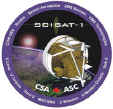 http://newsrelease.uwaterloo.ca/news.php?id=4098
http://newsrelease.uwaterloo.ca/news.php?id=4098
"The Canadian Space Agency satellite SCISAT-1 (ACE) is set to take Venus
Transit measurements using its on-board high-resolution Fourier transform
spectrometer. SCISAT-1 will observe the transit as part of the ACE studies
that are measuring and understanding the chemical processes that control the
distribution of atmospheric ozone in the Arctic;" from the University of
Waterloo.
